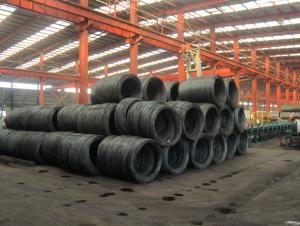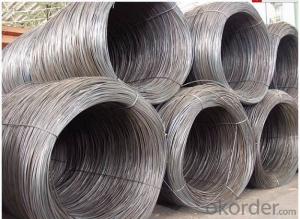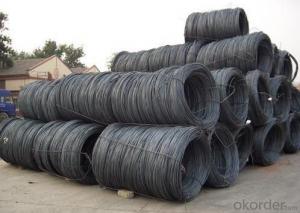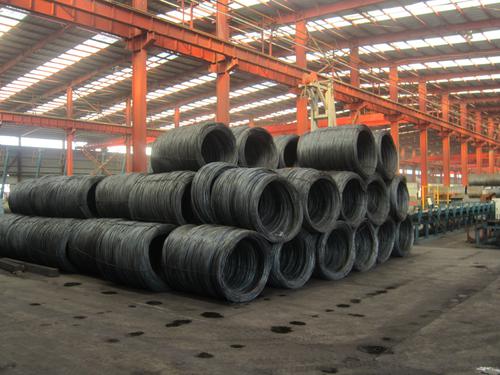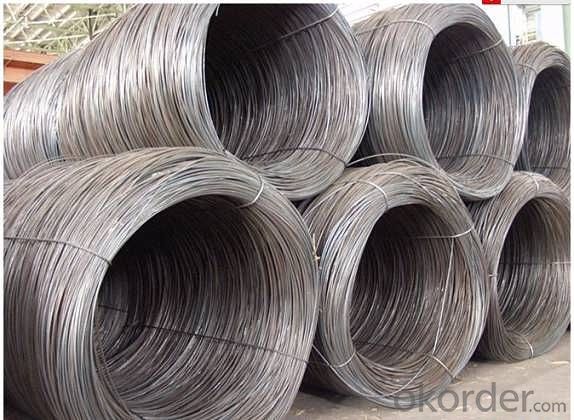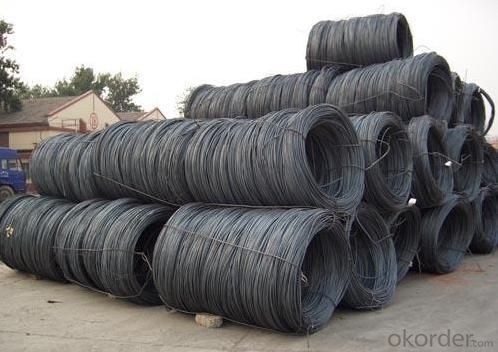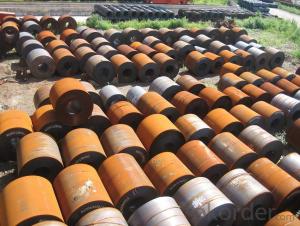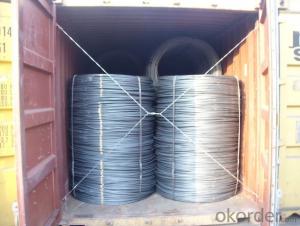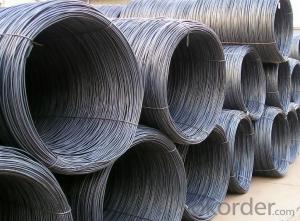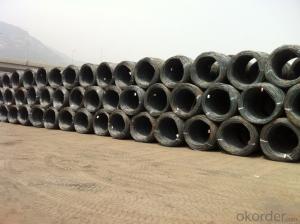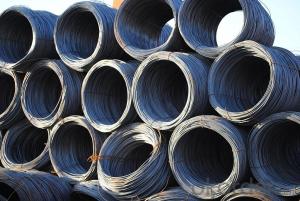GB Standard-Q195Steel Wire Rod with High Quality
- Loading Port:
- China Main Port
- Payment Terms:
- TT or LC
- Min Order Qty:
- 40 m.t
- Supply Capability:
- 15000 m.t/month
OKorder Service Pledge
OKorder Financial Service
You Might Also Like
Product Description:
Specifications of GB Standard-Q195Steel Wire Rod with High Quality:
Steel Grade: Q195 Standard:GB
Diameter: 6.5mm
6.5mm can be drawing into 2mm/8.0mm can be drawing into 3mm
Each coil weight about 2MT
Chemical Composition:
Please kindly find our chemistry of our material based on Q195 as below for your information
Trademark | Rank | Chemical composition (quality score) % | |||||
C | Si | Mn | S | P | |||
| ≤ |
| ≤ | ≤ | |||
Q195 |
| 0.06-0.12 | 0.30 | 0.25 | 0.050 | 0.045 | |
Trademark | Rank | Pulling Test | |||||
Bend PointΔs/Mpa | Tensile Strength | Elongation Ratioδ5% | |||||
Thickness (Diameter) /MM | Thickness (Diameter) /MM | ||||||
≤16 | 16-40 | ≤16 | 16-40 | ||||
≥ | ≥ | ||||||
Q195 |
| 195 | 185 | 315-390 | 33 | 32 | |
Usage and Applications of GB Standard-Q195Steel Wire Rod with High Quality:
After hot-rolled the products shaped into coil and delivery as finished product, including round, square, rectangular, hexagonal and so on. Since most of the products are round, it is generally called wire rod. Carbon steel wire rod is widely used in construction and manufacturing. Carbon steel wire rod is mainly used for reinforcement of reinforced concrete and welded structure or reprocessed (roberts , nail, etc.) materials, especially used to produce wire drawing, welding electrode, nails, spring, electronic, precise machinery parts and so on.
Production Process of GB Standard-Q195Steel Wire Rod with High Quality:
Steel billet---Heating---Rolling---Water-cooling---Coiling---Cooling---Inspection---Bundling---Exworks
Packaging & Delivery of GB Standard-Q195Steel Wire Rod with High Quality:
Packaging Detail: products are packed in coil and then shipped by container or bulk vessel
Each coil weight: About 2MT
Delivery Detail: within 45 days after received deposit or LC.
Label: to be specified by customer, generally, each bundle has 1-2 labels
Trade terms: FOB, CFR, CIF
FAQ:
Q1: How soon can we receive the product after purchasement?
A1: Within three days of placing an order, we will begin production. The specific shipping date is dependent upon international and government factors, but is typically one month.
Q2: How do you guarantee the quality of our products?
A2: We have established an advanced quality management system which conducts strict quality tests at every step, from raw materials to the final product. At the same time, we provide extensive follow-up service assurances as required.
Q3: The prices are invoicing on theoritical weight or on actual weight?
A3: We can do it in both manners, according to the customers' request.
Images of GB Standard-Q195Steel Wire Rod with High Quality:
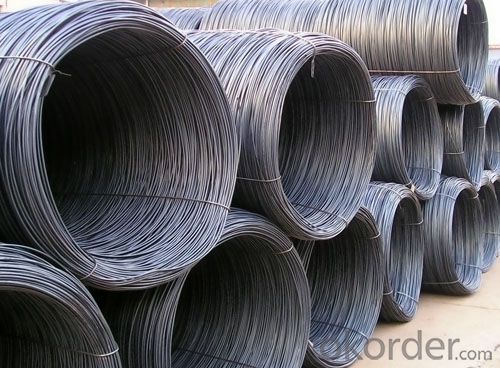
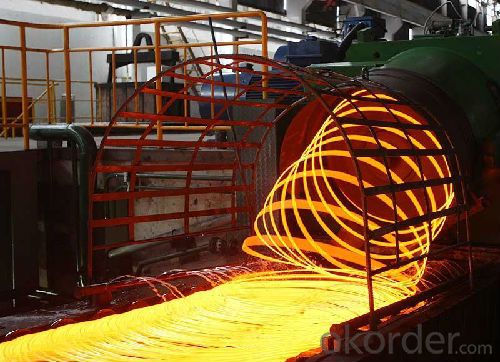
*If you would like to get our price, please kindly inform us the size, standard/material and quantity. Thank you very much for your attention.
- Q: How is steel wire rod used in the manufacturing of wire trays?
- Steel wire rod is used in the manufacturing of wire trays as it serves as the raw material for creating the wire mesh structure of the trays. The steel wire rod is first drawn and stretched to the desired diameter and then woven or welded together to form the wire mesh panels that make up the body of the trays. This provides the necessary strength, durability, and rigidity required for wire trays to securely hold and organize various items in industries like storage, transportation, and retail.
- Q: How is steel wire rod used in the manufacturing of kitchen utensils?
- Steel wire rod is commonly used in the manufacturing of kitchen utensils due to its high strength and durability. It is usually shaped and bent into the desired form to create handles, frames, or even components like whisks or sieves. The wire rod provides a sturdy structure to the utensils, ensuring their longevity and ability to withstand daily use in the kitchen.
- Q: How is steel wire rod used in the manufacturing of wire for shopping baskets?
- The manufacturing process of wire for shopping baskets heavily relies on steel wire rod. This rod acts as the primary material that undergoes a series of manufacturing steps to transform into wire. Initially, the steel wire rod is heated and passed through a set of rollers to gradually decrease its thickness and increase its length. This particular procedure, known as drawing, enhances the wire's tensile strength and flexibility. After the wire is drawn, it is typically coated with a protective layer to prevent corrosion and enhance its durability. This coating can be composed of materials such as zinc or plastic. Subsequently, the coated wire is shaped into the desired form, which is usually a mesh-like structure for shopping baskets. This shaping process, called welding, involves bending and joining the wire at specific points to form the basket shape. The selection of steel wire rod for manufacturing wire for shopping baskets is based on its strength, resilience, and ability to endure heavy loads. It ensures that the shopping baskets remain sturdy enough to carry various items without bending or breaking. Furthermore, the corrosion resistance properties of the steel wire rod guarantee a longer lifespan for the wire and ultimately the shopping baskets, even when exposed to moisture or challenging environments. In conclusion, steel wire rod plays a vital role in the manufacturing process of wire for shopping baskets. It serves as the fundamental raw material that is transformed into wire, which is then coated, shaped, and welded to create the final product. The strength, resilience, and corrosion resistance of the steel wire rod ensure that the shopping baskets are durable, long-lasting, and capable of withstanding the demands of everyday use.
- Q: What are the different coating options available for steel wire rod?
- Steel wire rod has a variety of coating options available, each with its own unique benefits and characteristics. Some commonly used coatings include: 1. Galvanized Coating: A widely favored option, galvanized coating involves applying a layer of zinc to the wire rod's surface. This provides exceptional corrosion resistance and enhances durability and lifespan. 2. Epoxy Coating: Applied to protect against corrosion and abrasion, epoxy coating creates a smooth and durable surface that prevents moisture and corrosive elements from reaching the wire rod. 3. Polymer Coating: Ideal for wire rod exposed to harsh environments, polymer coatings offer excellent resistance to corrosion, chemicals, and UV radiation. They also enhance the wire rod's aesthetic appearance. 4. Phosphating Coating: By chemically treating the wire rod, phosphating coating enhances corrosion resistance. It converts the surface into a layer of phosphate crystals, creating a protective barrier against rust and other forms of corrosion. 5. Powder Coating: Suitable for wire rod requiring a decorative finish, powder coating involves applying a dry powder to the wire rod and baking it to create a hard and durable coating. It provides excellent resistance to corrosion, chemicals, and scratches. 6. Ceramic Coating: Used for wire rod in extreme temperatures or abrasive environments, ceramic coatings offer excellent resistance to heat, wear, and corrosion. They also enhance the wire rod's strength and durability. Choosing the appropriate coating option is crucial and should be based on specific requirements and the intended application of the wire rod. Consulting with a coating specialist or manufacturer can help determine the most suitable coating option for the desired purpose.
- Q: How is steel wire rod used in the production of wire hangers?
- Steel wire rod is used in the production of wire hangers as the primary raw material. It is first drawn through a series of dies to reduce its diameter and increase its strength. The resulting wire is then cut into desired lengths and shaped into hanger forms using specialized machinery. The steel wire rod provides the necessary strength and durability required for wire hangers to support and hold clothing items.
- Q: What are the different surface coating materials used for steel wire rod?
- There are several different surface coating materials that can be used for steel wire rod to enhance its properties and protect it from corrosion. Some of the commonly used surface coating materials for steel wire rod include: 1. Zinc: Zinc coating is one of the most widely used surface coatings for steel wire rod. It provides excellent corrosion resistance and acts as a sacrificial layer, protecting the underlying steel from rust and oxidation. Zinc-coated steel wire rods are commonly known as galvanized wire rods. 2. Epoxy: Epoxy coatings are often used for steel wire rods that require resistance to chemicals, moisture, and abrasion. Epoxy coatings provide a durable, smooth, and protective layer that helps to prevent corrosion and improve the overall performance of the wire rod. 3. Phosphating: Phosphating is a surface treatment process that involves the conversion of the metal surface into a layer of phosphate crystals. Phosphating enhances the adhesion of subsequent coatings or paints, providing better corrosion resistance and improving the overall appearance of the steel wire rod. 4. Polymer Coatings: Polymer coatings are commonly used for steel wire rods that require specific properties such as electrical insulation, UV resistance, or high temperature resistance. These coatings are typically made from polymers such as PVC (polyvinyl chloride) or PE (polyethylene) and are applied using various techniques such as extrusion or dip coating. 5. Organic Coatings: Organic coatings, such as paints or lacquers, can also be used as surface coatings for steel wire rods. These coatings provide aesthetic appeal, as well as protection against corrosion and environmental factors. Organic coatings can be applied in various colors and finishes to meet specific requirements. It is important to note that the choice of surface coating material for steel wire rod depends on the intended application, environmental conditions, and desired properties. Manufacturers typically select the most suitable coating material based on the specific requirements of the wire rod and the end-use of the product.
- Q: What are the different storage methods for steel wire rod?
- There are several storage methods for steel wire rod, depending on factors such as the quantity, size, and condition of the rod. One common storage method is stacking the wire rod in a neat and organized manner. This can be done by creating rows of wire rod coils on a flat and stable surface, such as a concrete floor or a specially designed storage rack. The coils should be stacked in such a way that they do not roll or collapse, ensuring safety and easy access. Another storage method is using wire rod racks or shelves. These racks are specifically designed to hold wire rod coils securely, preventing them from rolling or shifting. They often have dividers or compartments to keep each coil separate and organized. In some cases, wire rod can be stored in vertical racks or stands. This method is especially useful when dealing with longer wire rod lengths. The rod is placed vertically and secured in place, minimizing the floor space required for storage. For outdoor storage, wire rod can be stored in designated areas using storage containers or shipping containers. This provides protection from the elements and ensures that the rod remains in good condition. Regardless of the storage method chosen, it is important to protect the wire rod from moisture, dust, and other contaminants. This can be achieved by using plastic or metal covers, or by storing the rod in a climate-controlled environment. It is worth noting that the specific storage method may vary depending on industry standards, regulations, and the specific requirements of the wire rod product. It is always recommended to consult with industry experts or manufacturers to determine the most suitable storage method for steel wire rod.
- Q: How are steel wire rods used in the manufacturing of bicycle spokes for strength and flexibility?
- Steel wire rods are used in the manufacturing of bicycle spokes to provide strength and flexibility. The high tensile strength of steel allows the spokes to withstand the weight and stress exerted on them while riding. Additionally, the flexibility of steel wire rods allows the spokes to absorb shocks and vibrations, contributing to a smoother and more comfortable ride.
- Q: What are the different types of steel wire rod surface defect monitoring and reporting tools?
- Some of the different types of steel wire rod surface defect monitoring and reporting tools include visual inspection tools, such as magnifying glasses and microscopes, automated inspection systems, like laser scanners and cameras, and specialized software for analyzing and reporting defects.
- Q: What are the different types of surface defects that can occur in steel wire rod?
- Some of the different types of surface defects that can occur in steel wire rod include scratches, pits, rust spots, scale, cracks, and surface discontinuities.
Send your message to us
GB Standard-Q195Steel Wire Rod with High Quality
- Loading Port:
- China Main Port
- Payment Terms:
- TT or LC
- Min Order Qty:
- 40 m.t
- Supply Capability:
- 15000 m.t/month
OKorder Service Pledge
OKorder Financial Service
Similar products
Hot products
Hot Searches
Related keywords
